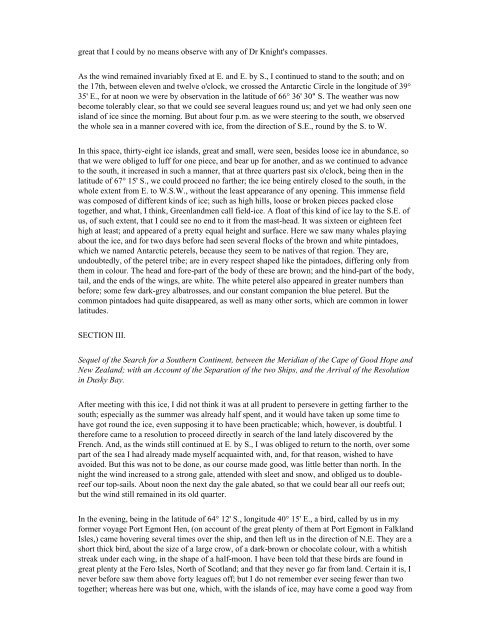A General History & Collection of Voyages and Travels ... - Nauticus
A General History & Collection of Voyages and Travels ... - Nauticus
A General History & Collection of Voyages and Travels ... - Nauticus
Create successful ePaper yourself
Turn your PDF publications into a flip-book with our unique Google optimized e-Paper software.
great that I could by no means observe with any <strong>of</strong> Dr Knight's compasses.As the wind remained invariably fixed at E. <strong>and</strong> E. by S., I continued to st<strong>and</strong> to the south; <strong>and</strong> onthe 17th, between eleven <strong>and</strong> twelve o'clock, we crossed the Antarctic Circle in the longitude <strong>of</strong> 39°35' E., for at noon we were by observation in the latitude <strong>of</strong> 66° 36' 30" S. The weather was nowbecome tolerably clear, so that we could see several leagues round us; <strong>and</strong> yet we had only seen oneisl<strong>and</strong> <strong>of</strong> ice since the morning. But about four p.m. as we were steering to the south, we observedthe whole sea in a manner covered with ice, from the direction <strong>of</strong> S.E., round by the S. to W.In this space, thirty-eight ice isl<strong>and</strong>s, great <strong>and</strong> small, were seen, besides loose ice in abundance, sothat we were obliged to luff for one piece, <strong>and</strong> bear up for another, <strong>and</strong> as we continued to advanceto the south, it increased in such a manner, that at three quarters past six o'clock, being then in thelatitude <strong>of</strong> 67° 15' S., we could proceed no farther; the ice being entirely closed to the south, in thewhole extent from E. to W.S.W., without the least appearance <strong>of</strong> any opening. This immense fieldwas composed <strong>of</strong> different kinds <strong>of</strong> ice; such as high hills, loose or broken pieces packed closetogether, <strong>and</strong> what, I think, Greenl<strong>and</strong>men call field-ice. A float <strong>of</strong> this kind <strong>of</strong> ice lay to the S.E. <strong>of</strong>us, <strong>of</strong> such extent, that I could see no end to it from the mast-head. It was sixteen or eighteen feethigh at least; <strong>and</strong> appeared <strong>of</strong> a pretty equal height <strong>and</strong> surface. Here we saw many whales playingabout the ice, <strong>and</strong> for two days before had seen several flocks <strong>of</strong> the brown <strong>and</strong> white pintadoes,which we named Antarctic peterels, because they seem to be natives <strong>of</strong> that region. They are,undoubtedly, <strong>of</strong> the peterel tribe; are in every respect shaped like the pintadoes, differing only fromthem in colour. The head <strong>and</strong> fore-part <strong>of</strong> the body <strong>of</strong> these are brown; <strong>and</strong> the hind-part <strong>of</strong> the body,tail, <strong>and</strong> the ends <strong>of</strong> the wings, are white. The white peterel also appeared in greater numbers thanbefore; some few dark-grey albatrosses, <strong>and</strong> our constant companion the blue peterel. But thecommon pintadoes had quite disappeared, as well as many other sorts, which are common in lowerlatitudes.SECTION III.Sequel <strong>of</strong> the Search for a Southern Continent, between the Meridian <strong>of</strong> the Cape <strong>of</strong> Good Hope <strong>and</strong>New Zeal<strong>and</strong>; with an Account <strong>of</strong> the Separation <strong>of</strong> the two Ships, <strong>and</strong> the Arrival <strong>of</strong> the Resolutionin Dusky Bay.After meeting with this ice, I did not think it was at all prudent to persevere in getting farther to thesouth; especially as the summer was already half spent, <strong>and</strong> it would have taken up some time tohave got round the ice, even supposing it to have been practicable; which, however, is doubtful. Itherefore came to a resolution to proceed directly in search <strong>of</strong> the l<strong>and</strong> lately discovered by theFrench. And, as the winds still continued at E. by S., I was obliged to return to the north, over somepart <strong>of</strong> the sea I had already made myself acquainted with, <strong>and</strong>, for that reason, wished to haveavoided. But this was not to be done, as our course made good, was little better than north. In thenight the wind increased to a strong gale, attended with sleet <strong>and</strong> snow, <strong>and</strong> obliged us to doublereefour top-sails. About noon the next day the gale abated, so that we could bear all our reefs out;but the wind still remained in its old quarter.In the evening, being in the latitude <strong>of</strong> 64° 12' S., longitude 40° 15' E., a bird, called by us in myformer voyage Port Egmont Hen, (on account <strong>of</strong> the great plenty <strong>of</strong> them at Port Egmont in Falkl<strong>and</strong>Isles,) came hovering several times over the ship, <strong>and</strong> then left us in the direction <strong>of</strong> N.E. They are ashort thick bird, about the size <strong>of</strong> a large crow, <strong>of</strong> a dark-brown or chocolate colour, with a whitishstreak under each wing, in the shape <strong>of</strong> a half-moon. I have been told that these birds are found ingreat plenty at the Fero Isles, North <strong>of</strong> Scotl<strong>and</strong>; <strong>and</strong> that they never go far from l<strong>and</strong>. Certain it is, Inever before saw them above forty leagues <strong>of</strong>f; but I do not remember ever seeing fewer than twotogether; whereas here was but one, which, with the isl<strong>and</strong>s <strong>of</strong> ice, may have come a good way from


